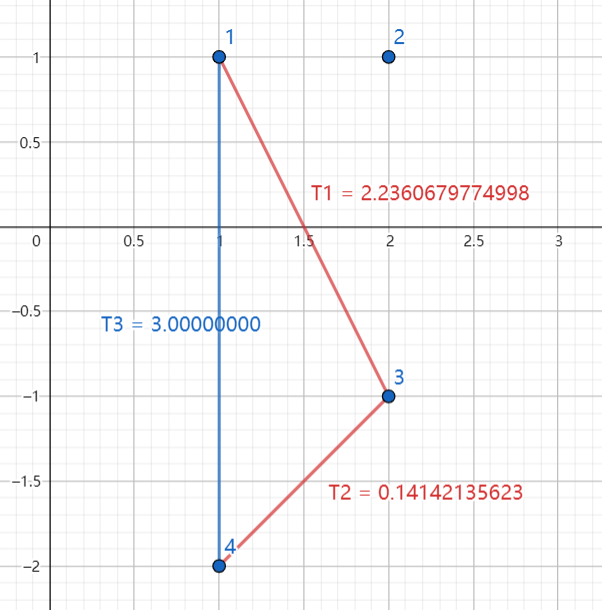Today little Klee wanted to go on an adventure outside. Klee wanted to go to so many places to play, but finally, she could only go to one place to play and she can pass away any number of times in other places.
First of all, let's consider the plane where Klee is located as a two-dimensional plane, which is divided into four quadrants, and there are $$$n$$$ points in the whole plane. Klee can only move directly from one point to another for each movement.
Since each quadrant represents a different country, the maximum speed that can be achieved differs for each quadrant. The ranges and maximum speeds of these four quadrants are defined as follows:
| quadrant | x | y | maximum speed |
| $$$1$$$ | $$$x \geq 1$$$ | $$$y \geq 1$$$ | $$$v_1$$$ |
| $$$2$$$ | $$$x \leq -1$$$ | $$$y \geq 1$$$ | $$$v_2$$$ |
| $$$3$$$ | $$$x \leq -1$$$ | $$$y \leq -1$$$ | $$$v_3$$$ |
| $$$4$$$ | $$$x \geq 1$$$ | $$$y \leq -1$$$ | $$$v_4$$$ |
If two points are in the same quadrant, Klee can reach the maximum speed given in that quadrant. For example, in one movement, if Klee's start point and Klee's endpoint are both located in the first quadrant, the maximum speed is $$$v_1$$$.
If the two points are not in the same quadrant, then Klee's speed must not be greater than $$$v_0$$$ to transfer directly in both quadrants. For example, in one movement, if Klee's start point is located in the first quadrant and Klee's endpoint is located in the second quadrant, the maximum speed is $$$v_0$$$ in this movement.
Now, given the initial index of the point that Klee is in and the final index of the point that Klee finally wants to play, please find the minimum time needed for Klee to get from the initial point to the final point.
The First line is an integer $$$n$$$ $$$(1 \leq n \leq 3 \cdot 10^3)$$$ indicating the number of points.
The second line contains $$$5$$$ integers $$$v_1, v_2, v_3, v_4, v_0$$$ $$$(1 \leq v_1, v_2, v_3, v_4, v_0 \leq 10^5)$$$ as described above.
The third line contains two integers $$$s, t$$$ $$$(1 \leq s, t \leq n)$$$, indicating the initial index of the point and the final index of the point.
For the following $$$n$$$ lines, the $$$i$$$-th line contains two integers $$$x_i, y_i$$$ $$$(-10^5 \leq x_i, y_i \leq 10^5, x_i \neq 0, y_i \neq 0)$$$, indicating the coordinate of the $$$i$$$-th point.
We ensure that there is no overlap between the two points(which means for any point $$$i$$$ and $$$j$$$, we can ensure that $$$x_i = x_j$$$ and $$$y_i = y_j$$$ do not occur simultaneously).
Output one line containing one integer indicating the minimum time needed for Klee to get from the initial point to the final point.
Your answer will be accepted if the absolute or relative error does not exceed $$$10^{-6}$$$. Formally, let your answer be a, and the jury's answer is b. Your answer is considered correct if $$$\frac{|a-b|}{max(1,|b|)}\leq 10^{-6}$$$.
3 1 2 3 4 5 1 3 1 -5 1 -1 1 1
1.2000000000
4 5 1 1 10 1 1 4 1 1 2 1 2 -1 1 -2
2.3414213562
3 1 1 1 1 100 1 3 1 1 2 -1 1 -100
1.0100000000
In the second test case:

Klee needs to move from point $$$1$$$ to point $$$4$$$.
She will first move from point $$$1$$$ to point $$$3$$$ with a speed of $$$v_0$$$, and then from point $$$3$$$ to point $$$4$$$ at a speed of $$$v_4$$$.
| Name |
|---|




